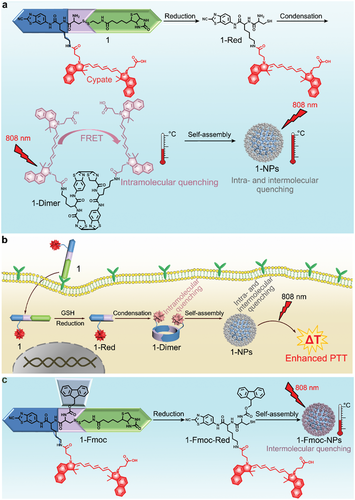A Smart Strategy to Increase Photothermal Therapeutic Efficiency
Professor LIANG Gaolin, JIANG Jun and ZHANG Qun, in cooperation with the team led by professor WANG Guangfeng from Anhui Normal University, developed a “smart” strategy to increase the photothermal therapeutic efficiency of their corresponding diseases. The study was published in Advanced Functional Materials.
Cancer is one of the leading causes of death worldwide and its treatment lies at the forefront of all human concerns. Photothermal therapy (PTT) is one of the noninvasive therapeutic methods for malignant tumor treatment which uses photoabsorbers to sufficiently convert the photon energy into heat to kill the cells via apoptosis, necroptosis, and/or necrosis pathway.
Owing to its precise spatiotemporal control, high specificity, and efficiency in tumor destruction, PTT has become a promising clinical approach for the treatment of a wide range of cancers.Design and synthesis of highly efficient photothermal agents (PTAs) are the key steps to realize a successful PTT.
In recent years, in situ fabrication of nanostructures has gained increasing attentions. However, thein situ simultaneous intra- and intermolecular quenching of the fluorescence of a PTA to enhance its PTT efficiency has not been reported.
In the study, researchers intended to design a “smart” small organic PTA which not only targets tumor cells but also whose fluorescence is subjected to both intra‐ and intermolecular quenching inside cells to achieve greatly enhanced PTT efficiency on tumor.
In the experiment, they usd a rationally designed photothermal agent Biotin‐Cystamine‐Cys‐Lys(Cypate)‐CBT (1), they developed a “smart” strategy of intracellular simultaneous intra‐ and intermolecular fluorescence quenching and applied it to largely increase the photothermal efficacy of the photothermal agent both in vitro and in vivo.
They envisioned that, by replacing the biotin group on 1 with other targeting warheads, the “smart” strategy is ready to increase the photothermal therapeutic efficiency of their corresponding diseases.

Strategies of using fluorescence quenching to enhance photothermal efficacy.(Image by Wei du et al.)
Moreover, recent studies revealed that PTT could act as an excellent, complementary tool for immunotherapy of cancer. In this case, tumors chosen for PTT are mainly superficial solid tumors. More recently, PTT has been applied as an adjuvant treatment for surgery resection of tumors.
In the future, they intend to apply their strategy on phototherapy‐synergized cancer immunotherapy or PTT‐assisted surgery to achieve a more efficient cancer therapy (especially for the treatment of breast cancer or melanoma cancer), where the PTAs can be in situ injected.
Paper link:
https://onlinelibrary.wiley.com/doi/full/10.1002/adfm.201908073
(Written by LI Xiaoxi, edited by LU Hongyu, USTC News Center)

